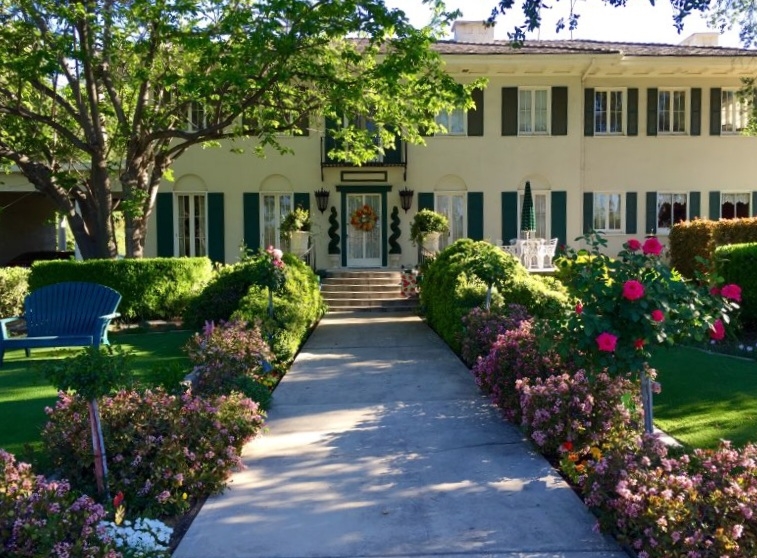
2022 HERITAGE AWARD RECIPIENT
The Redlands Area Historical Society, Inc.
Alfred Ferguson, Jr. Home
361 Franklin Avenue
1911
Set on the corner of Franklin Avenue and Oak Street in the Nob Hill neighborhood of Redlands Heights, is a Georgian style two story home with French influence. Designed by notable Redlands and Pasadena architect, F. Garvin Hodson, the plans for the 5 bedroom, 3 bathroom house were commissioned in a suite of rooms at the University Club of Redlands rented for the first half of the year 1911 by Albert Ferguson, Jr., of Reading, PA., and his great-uncle, Robert Douglas Millholland, who was a partner in the Redlands real estate firm of Harley & Millholland, as well as an orange grower and successor to C. M. Brown as manager of the Redlands Golden Orange Association. Millholland likely assisted his nephew with the selection of the site of the home, in an area of town noted for growing some of the highest quality of citrus.
The 9.8 acre parcel along “Oak Alley,” so-called for a long alley of California Live Oak trees, was purchased from New York banking heiress, noted Redlands horticulturalist and Redlands Horticultural Society founding member, Katherine Campbell Meigs of “Tall Trees” (419 Summit Avenue, Heritage Award, 1979). The two rear corners of the original grove parcel along Campbell Avenue were subdivided for a grove overseer, now 356 Campbell Avenue and for a grove worker, now 1368 Oak Street. The house that would become 361 Franklin Avenue has an almost twin home in 635 West Highland Avenue (Heritage Award, 1995) commissioned by Percy Harley, Robert Millholland’s business partner and Vice President of the University Club. Harley likely became aware of the developing plans for the Ferguson house through both connections and he commissioned the same architect, F. Garvin Hodson, to design his home later that year in 1911. The two houses, while similar on the exterior, are very different on the interior.
The Ferguson House was built to remind Fannie Ferguson of her family homes in Reading, PA. It was inspired both inside and out by Fannie’s childhood home, the Hunter family’s ancestral home, the manor house of the Sally Ann Furnace (1791-1881) near Reading, PA, a National Historic Landmark built in 1814 by Fannie Ferguson’s grandfather, Jacob van Reed Hunter, who named the property after his wife. Jacob Hunter developed and held patents on one of the first methods of the industrial smelting of iron ore, which he developed at the Sally Ann Furnace and used at a portfolio of eight ironworks near Reading. Among many things, the Sally Ann produced cannonballs for the Union Army in the Civil War as well as components for railroad locomotives.
Other architectural features of the home were inspired by the Ferguson family’s 1873 French Second Empire style home in the Centre District of Reading, PA. Albert Ferguson, Jr. was the only child of Fannie Curtis Hunter Ferguson and Albert Ferguson, Sr., the senior being an heir of an iron and banking fortune. Albert, Sr. died when his son was two years old. Albert, Sr.’s father, Nathaniel Ferguson, was a partner of the Robesonia Ironworks which developed the anthracite blast smelting process, operating a portfolio of three furnaces attached to 7,000 acres of resource-rich land and a company town. Customers of the Robesonia Furnace included The Panama Canal Authority, Westinghouse, and General Electric. The Robesonia Furnace would eventually be purchased by Bethlehem Steel. The sites of the Sally Ann and the Robesonia works are both National Historic Landmarks.
The Millhollands were similarly distinguished. Albert’s maternal grandmother, Harriet Millholland Hunter, was the daughter of James Millholland, a pioneer in the design of the steam-powered locomotive. He held over 150 patents for various features of steam locomotives and railroad bridges that were adopted as industry standard well into the 20th Century, including the first use of a bell and a cow-catcher on a locomotive, the hinged piston arm, and the superheater style of boiler. He was a member of the team that built America’s first steam locomotive, the “Tom Thumb.” He was later Master Machinist for the Reading Railroad, the founder of the Mount Savage Locomotive Works near Cumberland, Maryland, and finished his career as President of Consolidation Coal Company, which was the largest coal company in the United States (specializing in Anthracite) well into the 20th Century.
Albert, Jr. was an heir to all three of these fortunes, and he began to inherit at quite a young age. As the only son and grandson of the Ferguson family, he inherited the fortune and business interests of his father at age 2, and of his grandfather at age 3. His court-appointed financial guardians were selected from among the brightest business minds of the city of Reading, and each were bonded at $200,000 in 1890 (the equivalent of $6.35MM in 2022 currency) in order to fulfill the position. Albert did not attend university, but continued in the family tradition and began his career at the Baldwin Locomotive Works, where his great-uncle Henry Millholland had also worked. At age 23, Albert arrived in Redlands to plan and build what would become the family home, a gift for his mother, whose health was fragile. The land was purchased in 1911, the house appears to have been completed in 1912 from dated wallpaper fragments, and in the same year the home was placed into the name of his mother, Fannie C. Hunter Ferguson. It is notable that this neighborhood in particular attracted a concentration of occupants and guests with ties to various parts of the railroading and transportation industries. Records of the cost of construction and water connections have not been found.
The home is approached by a long walkway leading to demi-lune steps to a concrete veranda, which originally had a balustrade. The French door front door is flanked by pairs of French doors with ornamental long shutters and above the front door is another French door window with a decorative iron balcony. French doors are in use in the home’s interior space as well. Some of the home’s upstairs windows recess below the window sill for ventilation and to enjoy the California climate. To the left of the house is a porte-cochere and to the right is a telescopic kitchen wing which was always an original feature. It is a cosmetic nod to earlier times when historical kitchens were not located in the main home. The kitchen opens to the service porch with the original ice box service window. Also off the kitchen is a servant’s room and staircase with a laundry chute. The service porch was connected to the garage and chauffeur’s quarters by a lattice walkway covered with grapevines. The house has decorative boxed eaves.
Just as the house was completed, Mrs. Joseph Pulitzer (Kate Davis), the widow of newspaper mogul Joseph Pulitzer and the inheritor of his newspaper empire, stayed in the Ferguson House accompanied by her daughter Constance during the winter social season of 1913, after having spent several nights at the Hotel Green in Pasadena. Her daughter, the newly married Edith Pulitzer Moore, and son-in-law, William Scoville Moore, leased a home down the street at the corner of Franklin, Garden, and Elizabeth (1621 Garden Street, Heritage Award, 2017) between March and June of 1913 as they made their progress on an around-the-world honeymoon. Moore, a lawyer and heir to a New York real estate fortune, worked with Kate for much of 1912 on the settlement of the late Joseph Pulitzer’s estate, a process that would result in the foundation of the Columbia School of Journalism (1915) and the renowned literary prize it was charged to administer, the Pulitzer Prize (1917). It is possible some matters of the estate may have been discussed here. We know from archaeological evidence found at 1621 Garden Street that in the case of the Moore’s, they were consuming local foods and drinking local wines and brandies, which their staff were bringing up from Los Angeles, as Redlands was a dry city at the time. Mr. Moore and possibly other members of the family availed themselves of the Redlands Country Club nearby.
The selection of the two houses located close together may not have been entirely accidental, as it appears that the Davis and Millholland families may have also known each other socially and through the coal industry in Washington, DC. Notwithstanding, both Dunn and Millholland were engaged in local real estate and may have been able to broker the arrangement. The Pulitzer visit may have also had a lasting impact on this neighborhood; in the 1920s the daughter of Pulitzer’s Editor-in-Chief would move to the Nob Hill neighborhood with her husband, the heir to a Chicago meatpacking fortune allied with the Armours, and they built their own house a few blocks away from the Ferguson House on Grandview. Perhaps her family visited while the Pulitzers were in residence in Redlands, or perhaps they heard favorable things about the stay after the fact.
361 Franklin became the Ferguson Family’s primary residence immediately thereafter, and they settled into life as Redlands orange growers as noted in the City Directories. They attended the Presbyterian Church. Albert, Jr. was a member of the University Club. During World War I, Albert, Jr. served as a Corporal in a California unit, seeing action at multiple battles in the U.S. Army, including at Meuse-Argonne.
The Ferguson household consisted of Fannie, Albert Jr., and at various times Fannie’s widowed siblings-a brother, Henry Hunter, and sister, Sarah Hunter Howarth. The family also had employed members of the household; the house was initially equipped for at least a housekeeper and a chauffeur. Later, the family went on to employ multiple members of the Azorean Portuguese community in housekeeping, cooking, and grove management roles, including Mary Rezendes and Adeline & Frank Jacinto. Happy childhood memories of the daughter of Adeline & Frank Jacinto, Jane Jacinto Mishak, include spending time at the Ferguson home and being read to in a wicker chair by Mrs. Ferguson, whom she addressed as “Aunt Fannie,” and who had no grandchildren of her own.
The Ferguson House has a number of unique features, many of them evoking their long Pennsylvania roots. For example, the house has an outdoor brick hearth kitchen and bread oven at the rear of the house in an original, semi-enclosed solarium, with original cast iron oven doors and Dutch Oven crane arm, which among other features were likely cast in Reading, PA. This outdoor kitchen would have been used for baking breads as well as roasting meats and traditional colonial cooking. This feature is one-of-a-kind in Redlands and is highly unusual on the West Coast.
Another unique feature among the great houses of Redlands is the 1911 garage, still in nearly original condition. It has the original sliding doors as well as a mechanic’s pit for maintenance on the early automobiles the family would have owned. The garage also contains an apartment that has original interior access to the garage; this apartment is the chauffeur’s quarters. This garage was built at a very early point in the adoption of automobile technology in the United States and before the establishment of an auto dealership in Redlands. This structure reflects how the family embraced developments in transportation technology. Fannie’s uncle and Robert Douglas Millholland’s brother was a partner in the Duryea Motor Wagon Company, the first gasoline-powered automobile company in the United States. He was responsible for bringing Duryea from Massachusetts to Reading, PA. Among the appreciators of Duryea automobiles were the Henry Vanderbilts at the Biltmore; their original Stevens-Duryea can still be seen there.
Fannie Ferguson passed away in January 1940 and Albert Jr. passed away a few months later in August 1940. Fannie’s sister, Mary Hunter Foster of San Diego, CA made the funeral arrangements for Albert Jr., who never married and had no children. Both funerary preparations were made at Emmerson-Bartlett (then “Little Chapel of the Palms”) prior to burial in the family plot in Reading, PA. Albert’s uncle, Henry A. Hunter, who had resided with them in Redlands, moved back to Pennsylvania, and the estate was sold.
The house was then occupied by Fred Honey, the dealer for Chrysler-Plymouth in Redlands, until 1947. In 1954, the house was occupied by Ed Hales, Esq., a member of the Redlands Planning Commission, and his family. Many Redlanders may recognize the name because of Ed Hales Park in downtown Redlands. Upon his selling the property in 1964, the estate was subdivided down to its present 1.1 acres and then sold to Daniel Masters. In 1971, the home was sold to Dr. James Milliron, who then sold the home to its present owners, the Dr. David Gusseck family, in 1974. They are officially the single longest-standing owners of the Ferguson House at 48 years.
The Redlands Area Historical Society congratulates Dr. David and Mrs. Evelyn Gusseck on their 2022 Heritage Award and for their stewardship of 48 years.
Researched & written: Kathleen & John P. Beall
Presented
13 June 2022

